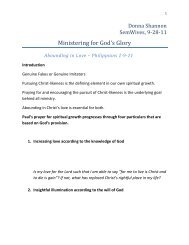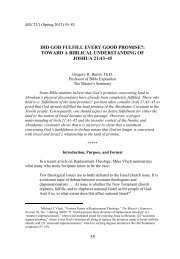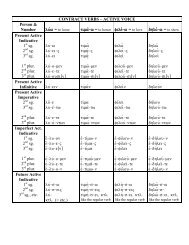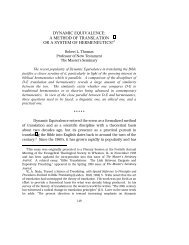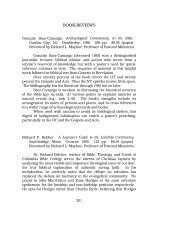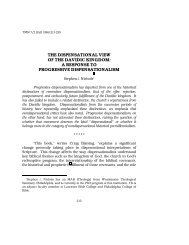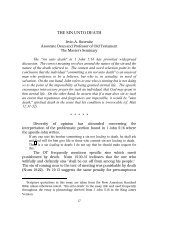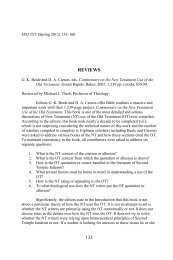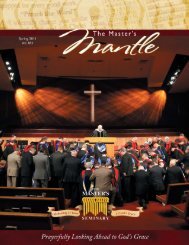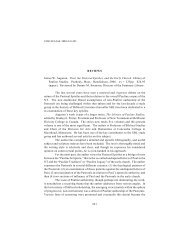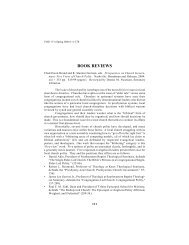Inductive and Deductive Methods as Applied to OT Chronology
Inductive and Deductive Methods as Applied to OT Chronology
Inductive and Deductive Methods as Applied to OT Chronology
You also want an ePaper? Increase the reach of your titles
YUMPU automatically turns print PDFs into web optimized ePapers that Google loves.
104 The M<strong>as</strong>ter’s Seminary Journalinherent in a proper treatment of all the observations just listed <strong>and</strong> their multiplecombinations. The e<strong>as</strong>y way <strong>to</strong> h<strong>and</strong>le this complexity is <strong>to</strong> make simplifying<strong>as</strong>sumptions. Thus the Seder Olam <strong>and</strong> the Talmud <strong>as</strong>sume that all reign lengths areme<strong>as</strong>ured from the start of the king’s sole reign. Gershon Galil made the opposite<strong>as</strong>sumption by presuming that all regnal years when a coregency is involved wereme<strong>as</strong>ured from the start of the coregency. 16 An even greater simplification w<strong>as</strong>invented by Wellhausen, who ruled out coregencies al<strong>to</strong>gether, even the plainlystatedcoregency of David with Solomon. 17 The consequences of this kind ofprocedure are obvious: the scholars who make such simplifying <strong>as</strong>sumptions will notagree with scholars who make other, contradic<strong>to</strong>ry <strong>as</strong>sumptions. The simplificationswill also produce chronologies that contradict scriptural texts at some point oranother; scholars will then, unjustifiably, claim that the Scripture is in error becauseit does not fit their scheme.Successes of the <strong>Inductive</strong> MethodIn contr<strong>as</strong>t, scholars who have used the inductive approach attempt <strong>to</strong> makeno a priori <strong>as</strong>sumptions. Instead, they employ scriptural texts <strong>to</strong> determine themethod used by the ancient authors, taking in<strong>to</strong> account the different archaeological<strong>and</strong> his<strong>to</strong>rical evidences listed above <strong>and</strong> not ruling out any possibility until validre<strong>as</strong>ons for doing so surface. In the 1920s Professor Coucke of the Gr<strong>and</strong> Seminairede Bruges determined from a careful analysis of the data in Kings <strong>and</strong> Chronicles thatJudah began its regnal years in Tishri, where<strong>as</strong> Israel began its regnal years inNisan. 18 He also determined that the reign lengths of the first kings of Judah <strong>and</strong>Israel were in harmony with each other if these first kings in Judah used accessionreckoning while their counterparts in Israel were using non-accession reckoning <strong>to</strong>me<strong>as</strong>ure their years of reign.Some years later an American scholar, Edwin Thiele, discovered the sameprinciples, although when he began publishing his findings, he w<strong>as</strong> not aware ofCoucke’s earlier work. Thiele w<strong>as</strong> able <strong>to</strong> determine the chronology of the kings ofIsrael <strong>and</strong> Judah in a more satisfac<strong>to</strong>ry way than Coucke, <strong>and</strong> his principal work, TheMysterious Numbers of the Hebrew Kings, went through three editions. The16 Gershon Galil, The <strong>Chronology</strong> of the Kings of Israel <strong>and</strong> Judah (Leiden: Brill, 1996) 10.17 Wellhausen w<strong>as</strong> followed in this presupposition by two more recent authors of <strong>OT</strong> chronologicalstudies: Jeremy Hughes, Secrets of the Times: Myth <strong>and</strong> His<strong>to</strong>ry in Biblical <strong>Chronology</strong> (Sheffield:Sheffield Academic, 1990) 99, 103, <strong>and</strong> Tetley, Reconstructed <strong>Chronology</strong> 117. After such rejection ofwell-established practices from the ancient Near E<strong>as</strong>t in order <strong>to</strong> make things simpler, such scholars findit necessary <strong>to</strong> make a plethora of secondary <strong>as</strong>sumptions in order <strong>to</strong> explain the disagreements of theirsystems with the data.18 V. Coucke, “Chronique biblique,” in Supplément au D ictionnaire de la Bible, Louis Pirot ed., vol.1 (1928), cited in Thiele, Mysterious Numbers 59 n. 17.



